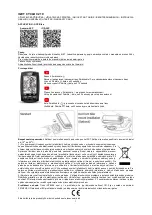
SP Range User Guide v7 June 2020
Installation & User Guide
SP Range
9
wrench). Do not use excessive torque and overtighten. Finally screw on the red terminal cap
or rubber cover to prevent short circuit and to ensure the securing nut remains tight.
6)
Note, do not attach any loads or charging sources to the unfused positive (
+ Unfused
)
.
Doing so would render the fuse ineffective and may overload the battery, tripping internal
protection which would require return to LBS.
7)
Second, connect the charging and load negative cables to the battery negative (
-
) terminal.
Place the flat washer on-top and then fasten the nut tight (or max 8Nm if you have a torque
wrench). Finally screw on the black terminal cap or rubber cover to prevent short circuit and
to ensure the securing nut remains tight.
5.2 DCS Model
The DCS model SP battery is exactly the same, however it includes an internal DC-DC charger meaning
it can be connected directly to a vehicle alternator / start battery via the DC-DC positive (
+
) and
negative (
-
) terminals only as illustrated in Figure 3.
Figure 3
–
DC-DC Charging Terminal Connections
The internal DC-DC charger contains a status LED light and Voltage Sensing Relay (VSR) adjustment
trim pot, which indicates and adjusts at what input voltage (from the vehicle alternator / start battery)
the DC-DC charger turns on and off. There is a dead-band of 0.5V, so that it typically turns on at 13.3V
and turns off at 12.8V.
Note that the voltage sensed by the DC-DC charger when it is charging, will be slightly different to the
voltage measured at the vehicle alternator / start battery. This is because of the voltage drop along
the cable from the alternator / start battery to the LBS battery. If this voltage drop is too high, a thicker
and/or shorter cable may be required.
Connect the alternator or start battery positive (
+
) first and negative (
-
) cables second to the M6
positive and negative on the DC-DC terminals.
1.
Once the vehicle engine is started, the green LED status light should illuminate if the battery
is charging. If the battery is not charging, check the:
a.
Cable size which may be too small with excessive voltage drop; and
b.
Voltage across the DC-DC terminals.
2.
The DC-DC charger typically begins charging at 13.3V, and then the green light turns on.
VSR adjustment
(trim pot) & LED
status light


































